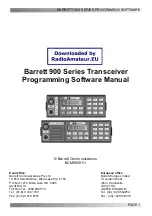
OG_MU-4-434_v10e Circuit Design, Inc.
22
OPERATION GUIDE
Note
4.4 Modes
The MU-4 has the following 3 modes.
1. Command mode (standard mode)
2. Text mode (for testing)
3. Binary mode (for testing)
Transmitting and receiving data is usually performed in the command mode. Use this mode when you build your
system. The text mode and binary mode are provided as testing modes, however you can also make applications
within the range of these functions.
When configuring your system, ensure that the source station and target station are in the
same mode. In addition, ensure that the relay function is used in the command mode.
4.4.1 Command mode
This is the basic mode for sending and receiving user data by radio.
The MU-4 commands consist of commands for transmitting and receiving data, and commands for control of the
parameters of the MU-4 unit itself. Changing the parameters, mode, and channel of the main unit cannot be
performed in the binary mode or text mode. Consider how to enable mode switching at the hardware design stage.
Control of the radio component is performed automatically by the MU-4, so you do not need to pay attention to this
aspect.
255 bytes of user data can be sent at one time.
It is convenient to use data transmit commands 1 and 2 for transmission of user system data and data transmit
command 3 if control is needed to transmit the data. The user can freely decide the format of those transmit
commands.
With transmit commands 2 and 3, it is possible to request return of an ‘ACK signal’ to show that the data is correctly
received at the target station. In addition, it is possible to output the same data from the relay station as from the
target station. This makes it possible to synchronize the system.
When the MU-4 receives data, since only correctly received data is output to the user application as a data receive,
it is processed on the user side properly.
4.4.2 Text mode (for testing)
This mode is used to check operation using RS232C communication software on a PC.
Text data can be input and output directly. This mode is convenient for transmitting and receiving characters
entered using a keyboard. Always add the
C
R
L
F
code as a terminator at the end of the character string. When the
MU-4 detects this terminator, it starts data transmission. Ensure that the maximum number of characters input is
within 255 bytes.
The C
R
L
F
code (0Dh, 0Ah) and Esc code (1Bh) cannot be sent by radio. However, the
C
R
L
F
code is
attached to the end of the data output from the target station as a terminator.
4.4.3 Binary mode (for testing)
This mode is used to check operation using RS232C communication software on a PC.
All 8-bit codes (00h to FFh) can be transmitted and received as data. 255 bytes of binary data can be input or output
directly at one time.
The input character string (max. 255 characters) is buffered until the buffer is filled with 255 characters, or until the
value set for the period during which no data is input is reached, and the character string is framed and transmitted.
The setting for the period during which no data is input is performed with the ‘@TB’ command.
















































